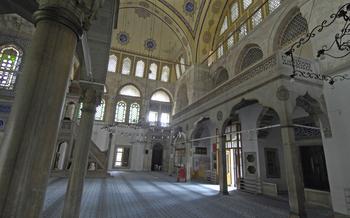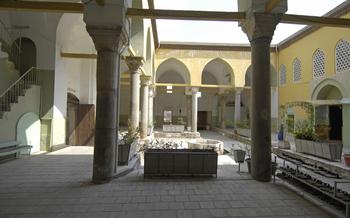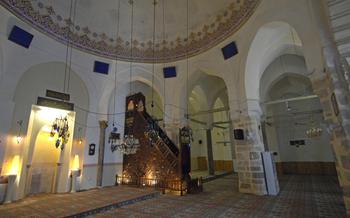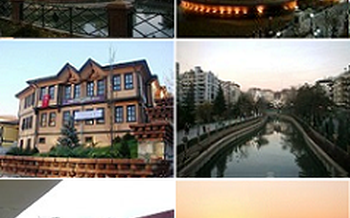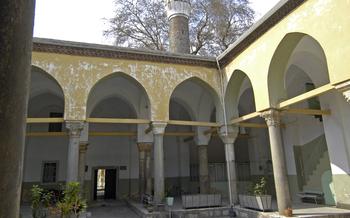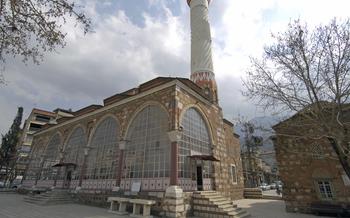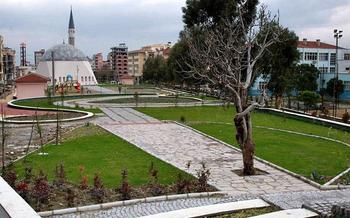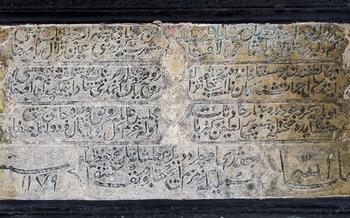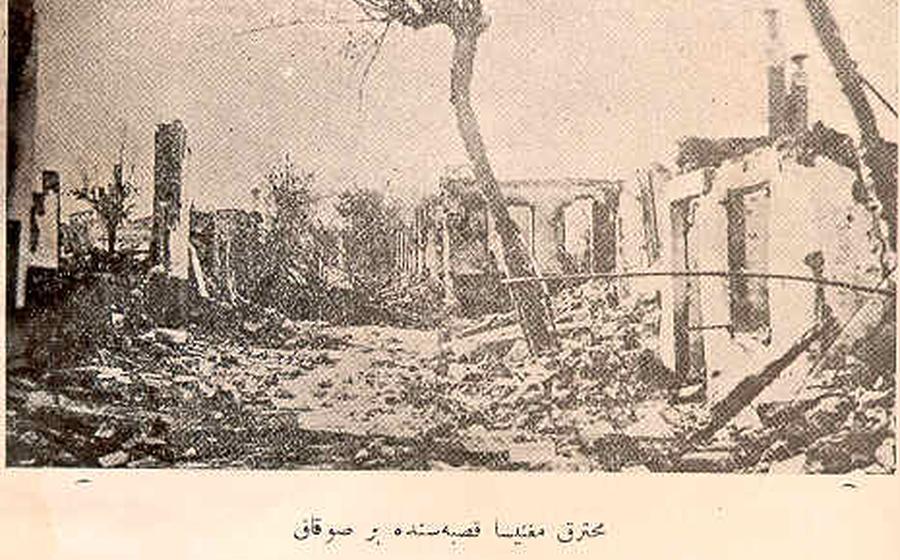
Beyazit Mosque Complex
- Beyazit Mosque Complex: A Journey Through History and Faith
- Architecture and Design
- Interior Splendor
- Cultural Importance
- Visiting Information
- Exploring the Complex
- Taking a Step Back in Time
- Appreciating the Craftsmanship
- Finding Inner Peace
- Capturing the Essence
- Discovering the Neighborhood
- Respecting Local Customs
- Exploring Other Mosques in Manisa
- Learning About Turkish Culture
- Insider Tip: Unveiling the Hidden Gem
Beyazit Mosque Complex: A Journey Through History and Faith
The Beyazit Mosque Complex stands as a testament to the rich history and cultural heritage of Manisa. Constructed in the 14th century, during the reign of the Ottoman Sultan Beyazit I, the mosque has served as a spiritual and cultural center for centuries. It is regarded as one of the most significant architectural landmarks in the city, embodying the fusion of Islamic and Anatolian architectural styles.
The mosque played a pivotal role in the development of Manisa as a major center of Islamic scholarship and education. It housed a madrasah, or Islamic school, where students from across the region gathered to study religious texts, philosophy, and science. The mosque's intricate architecture and serene atmosphere provided an ideal setting for contemplation and learning, fostering a vibrant intellectual community within the city.
Architecture and Design
Standing tall and proud, the Beyazit Mosque Complex showcases an awe-inspiring blend of architectural styles, reflecting the rich cultural heritage of Turkey. The mosque's exterior facade is a testament to the intricate craftsmanship and attention to detail that characterize Islamic architecture. Its towering minarets, reaching towards the heavens, serve as a beacon of faith and devotion. The domes, adorned with intricate patterns and calligraphy, add an air of grandeur and elegance to the mosque's silhouette.
Stepping closer, visitors are greeted by the mosque's intricate tilework, which covers every surface like a vibrant tapestry. The vibrant blues, greens, and reds create a mesmerizing kaleidoscope of colors, capturing the eye and drawing visitors into the mosque's sacred space. The calligraphy, etched into the tiles with precision and artistry, adds a layer of spiritual significance to the mosque's ornamentation.
The courtyard, a tranquil oasis in the heart of the complex, invites visitors to pause and reflect. The ablution fountain, with its cascading water, provides a soothing backdrop for contemplation and purification before entering the prayer hall. The courtyard's elegant arches and columns, bathed in the warm sunlight, create a serene and harmonious atmosphere.
Interior Splendor
As you step inside the Beyazit Mosque, you are greeted by a vast and awe-inspiring prayer hall. The elegance of the columns that line the space creates a sense of grandeur and devotion. Each column is adorned with intricate carvings and calligraphy, showcasing the artistry and skill of the craftsmen who built this sacred space.
The mihrab, a niche in the wall indicating the direction of Mecca, is adorned with stunning tilework and intricate carvings. Its beauty and craftsmanship draw the eyes to this focal point of the mosque, where the imam leads the prayers.
The minbar, the elevated platform from which the imam delivers sermons, is another remarkable feature of the interior. Its intricate woodwork and carvings display a blend of traditional Islamic design and Ottoman craftsmanship.
The mosque's chandeliers, suspended from the ceiling, add a touch of opulence to the interior. Their shimmering light illuminates the space, creating a warm and inviting atmosphere for worshippers.
The interior decorations of the Beyazit Mosque are not merely aesthetic embellishments; they hold deep symbolic and spiritual significance. The intricate patterns and designs represent Islamic beliefs and traditions, serving as a reminder of the mosque's sacred purpose.
Cultural Importance
The Beyazit Mosque Complex holds immense cultural significance for the local community in Manisa. It serves as a central place of worship, where Muslims from all walks of life congregate for daily prayers and religious observances. The mosque is also a vibrant community center, hosting various religious festivals and events throughout the year. These events bring people together, fostering a sense of unity and camaraderie among the Muslim community.
One of the most significant religious festivals celebrated at the mosque is Ramadan. During this holy month, the mosque transforms into a hub of activity, with special prayers, recitations, and communal meals organized for the faithful. The mosque's courtyard becomes a lively gathering place, where families and friends break their fast together, sharing food and exchanging stories in the spirit of Ramadan.
The Beyazit Mosque Complex is not just a religious center but also a symbol of Manisa's rich history and cultural heritage. Its architectural grandeur, intricate decorations, and spiritual atmosphere make it a significant landmark that draws visitors from near and far. The mosque stands as a testament to the city's Islamic roots and the enduring faith of its people.
Visiting Information
Visiting the Beyazit Mosque Complex is a unique and enriching experience that allows visitors to immerse themselves in Turkish history and culture. The mosque is open to the public daily, with visiting hours typically from 9 am to 5 pm. There is no entrance fee, and visitors are welcome to explore the mosque and its complex at their own pace. However, it is important to note that the mosque is an active place of worship, and visitors are expected to be respectful of the religious significance of the place. Appropriate clothing is required, and visitors are advised to dress modestly, covering their shoulders and knees. The best time to visit the mosque is during the early morning or late afternoon when the light is most favorable for photography and when the crowds are smaller. This allows visitors to fully appreciate the mosque's architectural details and soak in its serene atmosphere without distractions.
Exploring the Complex
Beyond the main mosque, the Beyazit Mosque Complex encompasses several other structures that add to its historical and architectural significance. The madrasah, or Islamic school, is a prominent feature of the complex, dating back to the same period as the mosque. It comprises a series of classrooms, a library, and living quarters for students, reflecting the importance of education in Islamic society.
Adjacent to the mosque is the türbe, a mausoleum where the founder of the complex, Beyazit I, and his family members are laid to rest. The türbe's intricate tilework and calligraphy echo the decorative motifs found in the mosque, creating a harmonious visual ensemble.
To fully appreciate the complex's grandeur, take a leisurely stroll through its grounds, admiring the interplay of architectural elements and the serene ambiance. Follow a circular route, starting from the mosque's main entrance and gradually exploring the madrasah, türbe, and the surrounding gardens. This immersive experience will transport you back in time, allowing you to grasp the multifaceted nature of this architectural masterpiece.
Taking a Step Back in Time
As I stepped through the gates of the Beyazit Mosque Complex, I felt an immediate sense of awe and tranquility. The towering minarets, intricate tilework, and elegant domes transported me back in time, offering a glimpse into Turkey's rich history and architectural heritage. The atmosphere was serene and peaceful, with the gentle sound of birdsong echoing through the courtyard. I couldn't help but feel a deep sense of connection to the past as I wandered through the complex, imagining the generations of worshippers who had come before me. The Beyazit Mosque Complex was more than just a religious site; it was a living testament to the enduring legacy of Islamic culture in Turkey.
Appreciating the Craftsmanship
The Beyazit Mosque Complex is a testament to the intricate craftsmanship and attention to detail that characterized Islamic architecture during the 14th century. Every element of the mosque, from its towering minarets to its delicate tilework, showcases the skill and artistry of the artisans who built it.
The intricate geometric patterns and floral motifs that adorn the mosque's exterior and interior are a testament to the precision and creativity of the craftsmen. The calligraphy, which adorns the mihrab and other parts of the mosque, is a masterpiece of Islamic calligraphy, demonstrating the skill and patience of the calligraphers who created it.
The mosque's stained-glass windows are another highlight, filtering the sunlight into the prayer hall in a kaleidoscope of colors. The windows depict scenes from the Quran and Islamic history, adding to the mosque's spiritual and aesthetic appeal.
The Beyazit Mosque Complex is a true masterpiece of Islamic architecture, and its beauty lies not just in its grandeur but also in its intricate details. The mosque is a testament to the skill and dedication of the artisans who created it, and it continues to inspire and awe visitors to this day.
Finding Inner Peace
As you step inside the Beyazit Mosque Complex, a sense of tranquility and serenity washes over you. The spacious prayer hall, with its elegant columns and intricate decorations, creates an atmosphere conducive to contemplation and prayer. The soft glow of the chandeliers illuminates the mihrab, the focal point of the mosque, where the imam leads the prayers. The air is filled with the melodious sound of Quranic recitations, adding to the spiritual ambiance. Whether you are a Muslim or not, you cannot help but feel a sense of reverence and awe as you stand in this sacred space. The Beyazit Mosque Complex is not just a place of worship; it is a sanctuary for the soul, a place where you can find inner peace and connect with your spiritual side.
Capturing the Essence
To capture the essence of the Beyazit Mosque Complex through photography, consider the following tips:
-
Golden Hour Magic: Visit the mosque during the golden hours of sunrise or sunset to capture the warm and ethereal light that casts a magical glow on the architecture.
-
Symmetry and Lines: Take advantage of the mosque's symmetrical design by positioning yourself directly in front of the facade to capture the perfect balance and harmony of the structure.
-
Details and Close-ups: Don't just focus on the grand exterior; zoom in on intricate details like the tilework, calligraphy, and carvings to showcase the exquisite craftsmanship.
-
Interior Splendor: Step inside the prayer hall and capture the grandeur of the columns, mihrab, and chandeliers, paying attention to the play of light and shadow.
-
Unique Perspectives: Explore different angles and vantage points around the complex to find unique compositions, such as shooting from the courtyard or from the top of the madrasah.
-
People and Atmosphere: Include people in your shots to convey the mosque's vibrant atmosphere and sense of community.
-
Local Life: Capture the daily life surrounding the mosque, such as locals going about their prayers or gathering for religious events.
Discovering the Neighborhood
The Beyazit Mosque Complex is not just a standalone structure but is deeply embedded in the historical fabric of Manisa. The surrounding neighborhood, known as the Beyazıt Mahallesi, is a treasure trove of history and architectural wonders. Take a stroll through its narrow cobblestone streets, lined with traditional Ottoman houses and charming cafes. Visit the nearby Manisa Museum, which houses a collection of artifacts and exhibits that provide a glimpse into the city's rich past.
Don't miss the historic Manisa Clock Tower, an iconic landmark that stands tall in the heart of the neighborhood. Built in the 19th century, this majestic tower offers panoramic views of the city and is a popular spot for locals and tourists alike. The neighborhood is also home to numerous shops, boutiques, and restaurants, where you can find local handicrafts, savor traditional Turkish cuisine, and experience the vibrant atmosphere of Manisa's daily life.
Respecting Local Customs
When visiting the Beyazit Mosque Complex, it is essential to be mindful of local customs and traditions to show respect for the religious significance of the place. Visitors should dress modestly, avoiding revealing or tight-fitting clothing. Women should cover their heads with a headscarf as a sign of respect. Upon entering the mosque, visitors should remove their shoes and place them on the designated shelves. It is also important to maintain silence and avoid disturbing those who are praying. Taking photographs is generally permitted, but visitors should be mindful not to disrupt others or take photos of people without their consent. By observing these simple guidelines, visitors can ensure a respectful and enriching experience at the Beyazit Mosque Complex.
Exploring Other Mosques in Manisa
While the Beyazit Mosque Complex stands as a testament to Manisa's rich Islamic heritage, it is not the only mosque worth exploring in the city. For those seeking a deeper immersion into the diverse architectural styles and historical significance of Turkish mosques, a mosque-hopping tour of Manisa is a must.
One notable mosque is the Muradiye Mosque, built in the 16th century during the reign of Sultan Murad III. This magnificent mosque features a stunning dome, intricate tilework, and a spacious courtyard. Its architectural grandeur is a testament to the opulence and power of the Ottoman Empire.
Another must-see is the Hacı Ilyas Mosque, dating back to the 15th century. This mosque is renowned for its beautiful stone carvings, intricate calligraphy, and a unique octagonal minaret. Its serene atmosphere and historical significance make it a popular destination for both locals and visitors.
For those interested in exploring further, the Kurşunlu Mosque, built in the 17th century, offers a unique blend of architectural styles. Its striking dome, elegant minarets, and ornate interior decorations showcase the transition from Seljuk to Ottoman architecture.
Embarking on a mosque-hopping tour in Manisa allows visitors to appreciate the diversity and richness of Islamic architecture in the city. Each mosque offers a unique glimpse into the history, culture, and religious traditions of Turkey. Whether you are a history buff, an architecture enthusiast, or simply seeking spiritual enlightenment, Manisa's mosques offer an unforgettable journey through time and culture.
Learning About Turkish Culture
Visiting the Beyazit Mosque Complex offers a glimpse into the rich tapestry of Turkish culture and history. Mosques hold a central place in Turkish society, serving not only as places of worship but also as community centers and symbols of cultural identity. Their architecture, intricate decorations, and spiritual significance reflect the deep-rooted Islamic traditions and beliefs that have shaped Turkey's cultural landscape.
Exploring the mosque complex allows visitors to understand the importance of religion in Turkish daily life. They can observe the rituals and customs associated with prayer, witness the vibrant communal atmosphere during religious festivals, and learn about the role of mosques in fostering a sense of unity and belonging among the local community.
Moreover, the mosque's exquisite architecture and artwork showcase the remarkable craftsmanship and artistic prowess of Turkish artisans. The intricate tilework, calligraphy, and ornamental details reflect the country's rich artistic heritage and demonstrate the high level of skill and creativity that Turkish craftsmen possessed.
By immersing themselves in the atmosphere of the Beyazit Mosque Complex, visitors can gain a deeper appreciation for Turkish culture and history. The mosque stands as a testament to the country's Islamic heritage, its vibrant communal spirit, and its enduring legacy of artistic excellence.
Insider Tip: Unveiling the Hidden Gem
Beyond the main prayer hall, venture into the tranquil courtyard of the Beyazit Mosque Complex, where a hidden gem awaits discovery. Nestled amidst the serene surroundings, you'll find a centuries-old plane tree, its gnarled branches reaching towards the sky like a silent guardian. According to local folklore, this magnificent tree is believed to possess mystical powers and is revered by the community. Take a moment to sit beneath its shade, soak in the serenity, and let your imagination wander back in time.
